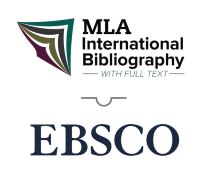The motivation of EFL public school teachers: what can self-theories tell us?
DOI:
https://doi.org/10.26512/rhla.v11i2.1191Palavras-chave:
Teacher motivation;, Self-beliefs;, English teaching;, Teacher educationResumo
In this paper, I report on a qualitative research study in progress, carried out with two English teachers, working in elementary education in a public school in Minas Gerais. I sought to investigate the motivation of these teachers, in light of self-theories (MARKUS; NURIUS, 1986; HIGGINS, 1987). Data collection methods include a questionnaire, an interview, classroom notes and video-stimulated recall sessions. Results show the important role played by positive and negative self-beliefs (whether actual or future) in teachers’ motivational flux. I conclude the article by emphasizing the need for encouraging the reflection on self-beliefs and affective factors that could impact on action and the sharing of experience in teacher education and in continuing education programs in order to engender a positive motivational cycle in schools.
Downloads
Referências
BORG, Simon. Teacher cognition in language teaching: a review of research on what language teachers think, know, believe, and do. Language Teaching, v. 36, 2003, p. 81-109.
BROWN, H.Douglas. Principles of language learning and teaching. Englewood Cliffs, Prentice Hall, 1994.
BISHAY, Andre. Teacher motivation and job satisfaction: a study employing the experience sampling method. Journal of Undergraduate Sciences, v. 3, p. 147-154, 1996.
COATES; Thomas J.; THORESEN, Carl E. Teacher anxiety: a review with recommendations. Review of Educational Research, v. 46, n. 2, p. 159-184, 1976.
DAY, Christopher.; KINGTON, Alison.; STOBART, Gordon.; SAMMONS, Pam. The personal and professional selves of teachers: stable and unstable identities. British Educational Research Journal, v. 32, n.4, p. 601-616, 2006.
DECI, Edward L.; KASSER, Tim.; RYAN, RichardM. Self-determined teaching: opportunities and obstacles. In: BLESS, James L. (Ed). Teaching well and liking it: motivating faculty to teach effectively. Baltimore, USA: The Johns Hopkins University Press, 1997, p. 57-71.
DÖRNYEI, Zoltan. Teaching and researching motivation. England: Longman, 2001a.
______. New themes and approaches in second language motivation research, Annual Review of Applied Linguistics, v. 21, p. 43-61, 2001b.
_____.The psychology of the language learner: Individual Differences in Second Language Acquisition. New Jersey: Lawrence Erlbaum Associates Publishers, 2005.
DÖRNYEI, Zoltan; USHIODA, Ema. (orgs). Teaching and researching motivation. Harlow: Longman, 2011.
GILLHAM, Bill. Case study research methods. Londres e Nova Iorque: Continuum, 2000.
HARGREAVES, A. The emotional practice of teaching, Teaching and Teacher Education, v. 14, n. 8, p. 835-854, 1998.
HIGGINS, Edward Tory. Self-discrepancy theory. Psychological Review, v. 94, n. 3, p. 319-340, 1987.
KUBANYIOVA, Maggie. Possible selves in language teacher development. In: DÖRNYEI, Zoltan; USHIODA, Ema. (orgs). Motivation, language identity and the L2 self. Bristol, Buffalo, Toronto: Multilingual Matters, 2009, p. 314-332.
LAMB, Martin. Integrative motivation in a globalizing world. System, v. 32, p. 3-19, 2004.
LEONDARI, Angeliki.; SYNGOLLITOU, Efi.; KIOSSEOGLOU, Grigoris. Academic achievement, motivation and possible selves. Journal of Adolescence, v. 21, p. 219-222, 1998.
MARCUSCHI, Luiz Antônio. Análise da conversação. São Paulo: Ed. Ática, 2000.
MARKUS, Hazel.; NURIUS, Paula. Possible selves. American Psychologist, v. 41, n. 4, p. 954-969, 1986.
MARKUS, Hazel.; WURF, Elissa. The dynamic self-concept. Annual Review of Psychology, v. 38, p. 299-337, 1987.
MORGAN, Mike.; KITCHING, Karl.; O’LEARY, Michael. The Psychic Rewards of Teaching: examining global, national and local influences on teacher motivation. In: ANNUAL MEETING OF THE AMERICAN EDUCATIONALRESEARCH ASSOCIATION,2007, Chicago, EUA.
OYSERMAN, Daphna. Self-concept and identity. In: TESSOR, Abraham; SCHWARZ, Norbert (Ed). Blackwell Handbook of Social Psychology. New York: Oxford University Press, 2001, p. 499 ”“517.
OYSERMAN, Daphna.; JAMES, L. Possible selves: from content to process. In: MARKMAN, K.; KLEIN, William M.P.; SUHR, Julie A. (eds). The handbook of imagination and mental stimulation. New York: Psychology Press, 2009, p. 373-394.
PENNINGTON, Martha C. Work satisfaction and the ESL profession. Language, Culture and Curriculum, v. 4, n. 1, p. 59-86, 1991.
POWELL, E. Conceptualizing and facilitating active learning: teacher’s video-stimulated reflective dialogues. In: BRITISH EDUCATIONAL RESEARCHASSOCIATION CONFERENCE, 2004, Manchester, England.
PRAVER, Max.; OGA-BALDWIN, William. What motivates language teachers: investigating work satisfaction and second language pedagogy. Polyglossia,v. 14, p. 1-8, 2008.
REITANO, Paul.The value of video stimulated recall in reflective teaching practices.In: AUSTRALIAN CONSORTIUMFOR SOCIAL AND POLITICALRESEARCH INC. (ACSPRI) SOCIAL SCIENCE METHODOLOGY CONFERENCE, 2006, New South Wales.
RUVOLO, Ann.; MARKUS, Hazel. Possible selves and performance: thepower of self-relevant imagery. Social Cognition, v. 10, p.95-124, 1992.
SINCLAIR, Kenneth E.; BARNES, Jenny. Can anxiety about teaching be measured? In: AARE’SCANBERRA CONFERENCE PAPERS, 2009, Canberra, Australia.
USHIODA, Emma; DÖRNYEI, Zoltan. Motivation. In: GASS, Susan.; MACKEY, Alison. (Ed). The Routledge handbook of second language acquisition. New York: Routledge, 2012, p. 396-409.
WALKER, Charles J.; SYMONS, Cynthia. The meaning of human motivation. In: BLESS, James L. (ed). Teaching well and liking it: motivating faculty to teach effectively. Baltimore,USA: The Johns Hopkins University Press, 1997, p. 3-18.
YASHIMA, Tomoko. Autonomy and willingness to communicate. Development of an English-using ideal self. In: INDEPENDENT LEARNING ASSOCIATIONJAPAN CONFERENCE, 2007, Chiba, Japan.
ZEMBYLAS, Michalinos. Beyond teacher cognition and teacher beliefs: the value of the ethnography of emotions in teaching. International Journal of Qualitative Studies in Education, v.18, n. 4, p. 465-487, 2005.
Downloads
Publicado
Como Citar
Edição
Seção
Licença

A Revista Horizontes de Linguística Aplicada de http://seer.bce.unb.br/index.php/horizontesla/index é licenciado sob uma Licença Creative Commons Atribuição-Uso não-comercial-Vedada a criação de obras derivadas 3.0 Unported.
- Autores mantém os direitos autorais e concedem à revista o direito de primeira publicação, sendo o trabalho simultaneamente licenciado sob a Creative Commons Attribution License o que permite o compartilhamento do trabalho com reconhecimento da autoria do trabalho e publicação inicial nesta revista.
- Autores têm autorização para assumir contratos adicionais separadamente, para distribuição não-exclusiva da versão do trabalho publicada nesta revista (ex.: publicar em repositório institucional ou como capítulo de livro), com reconhecimento de autoria e publicação inicial nesta revista.







